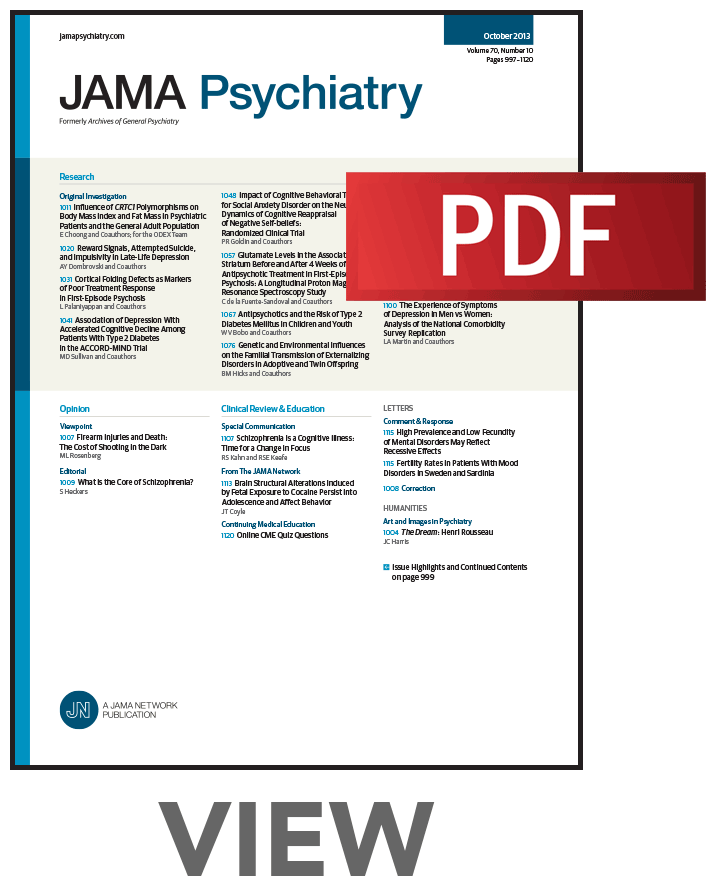Patient Self-Guided Interventions to Reduce Sedative Use and Improve Sleep: The YAWNS NB Randomized Clinical Trial.
IF 22.5
1区 医学
Q1 PSYCHIATRY
引用次数: 0
Abstract
Importance Direct-to-patient interventions enabling transitions from long-term benzodiazepine receptor agonist (BZRA) use to cognitive behavioral therapy for insomnia (CBTI) by older adults has the potential to reduce BZRA use and related harms while improving sleep outcomes without requiring prearranged clinician involvement. Objective To compare 2 direct-to-patient behavior change interventions with treatment as usual (TAU) on BZRA use, sleep, and other health outcomes, and uptake of CBTI techniques. Design, Setting, and Participants The Your Answers When Needing Sleep in New Brunswick (YAWNS NB) study was a 3-arm, pragmatic, open-label, minimum-contact, randomized clinical trial. The study began November 2020 and ended June 2022. Participants were randomly allocated to 1 of 3 groups, including 2 different mailed behavior change interventions or no intervention (TAU). Participants were from communities across the province of New Brunswick, Canada, and included adults 65 years and older living independently with long-term use of BZRAs and current or past insomnia. Interventions The Sleepwell package (YAWNS-1) consisted of a cover letter and 2 booklets ("How to Stop Sleeping Pills" and "How to Get Your Sleep Back"). The other package (YAWNS-2) included updated versions of the 2 booklets ("You May Be at Risk" and "How to Get a Good Night's Sleep Without Medication") used in the Eliminating Medications Through Patient Ownership of End Results (EMPOWER) study. Main Outcomes and Measures BZRA use at 6 months was the primary measure. Secondary measures included CBTI use, sleep, insomnia, daytime sleepiness, safety, anxiety, frailty, and quality of life. Results A total of 1295 individuals expressed interest in the study, and 565 (43.6%) completed a baseline assessment. Participants had a mean (SD) age of 72.1 (5.7) years, a mean (SD) BZRA use duration of 11.4 (9.1) years, and 362 (64.1%) were female. Discontinuations and dose reductions of 25% or greater were highest with YAWNS-1 (50 of 191 [26.2%]; 39 of 191 [20.4%]; total, 46.6%) compared with YAWNS-2 (38 of 187 [20.3%]; 27 of 187 [14.4%]; total, 34.8%, P = .02) and TAU (14 of 187 [7.5%]; 24 of 187 [12.8%]; total, 20.3%, P < .001). YAWNS-1 also demonstrated better uptake of CBTI techniques and sleep outcomes compared with YAWNS-2 (new CBTI techniques: 3.1 vs 2.4; P =.03; sleep efficiency change: 4.1% vs -1.7%; P =.001) and reduced insomnia severity and daytime sleepiness compared with TAU (insomnia severity index change: -2.0 vs 0.3; P <.001; Epworth Sleepiness Scale change: -0.8 vs 0.3; P =.001). Conclusions and Relevance Results of the YAWNS NB randomized clinical trial show that, as a simple, scalable, direct-to-patient intervention, YAWNS-1 substantially reduced BZRA use and improved sleep outcomes. It could be implemented to transform insomnia care for older adults at the population level. Trial Registration ClinicalTrials.gov Identifier: NCT04406103.减少镇静剂使用和改善睡眠的患者自我指导干预:YAWNS NB 随机临床试验。
重要性直接对患者进行干预,使老年人从长期使用苯二氮卓受体激动剂(BZRA)过渡到失眠认知行为疗法(CBTI),有可能减少 BZRA 的使用和相关危害,同时改善睡眠效果,而无需事先安排临床医生参与。设计、设置和参与者新不伦瑞克睡眠需求时您的答案(YAWNS NB)研究是一项三臂、务实、开放标签、最小接触、随机临床试验。研究于 2020 年 11 月开始,2022 年 6 月结束。参与者被随机分配到 3 组中的 1 组,包括 2 种不同的邮寄行为改变干预措施或无干预措施(TAU)。参与者来自加拿大新不伦瑞克省的各个社区,包括65岁及以上独立生活、长期服用BZRAs、目前或过去曾失眠的成年人。干预措施睡眠健康套餐(YAWNS-1)包括一封封面信和两本小册子(《如何停止服用安眠药》和《如何恢复睡眠》)。另一种套餐(YAWNS-2)包括 "通过患者自主决定最终结果来消除药物"(EMPOWER)研究中使用的两本小册子(《您可能面临风险》和《如何在不服药的情况下获得良好睡眠》)的更新版本。次要测量指标包括 CBTI 使用情况、睡眠、失眠、白天嗜睡、安全、焦虑、虚弱和生活质量。结果共有 1295 人表示有兴趣参与研究,其中 565 人(43.6%)完成了基线评估。参与者的平均(标清)年龄为 72.1 (5.7)岁,平均(标清)服用 BZRA 的时间为 11.4 (9.1)年,其中 362 人(64.1%)为女性。YAWNS-1(191 例中有 50 例 [26.2%];191 例中有 39 例 [20.4%];总计 46.6%)与 YAWNS-2 (187 例中有 38 例 [20.3%];187 例中有 27 例 [14.4%];总计 34.8%,P = .02)和 TAU(187 例中有 14 例 [7.5%];187 例中有 24 例 [12.8%];总计 20.3%,P < .001)相比,停药和剂量减少 25% 或更多的比例最高。与 YAWNS-2 相比,YAWNS-1 还显示出更好的 CBTI 技术接受率和睡眠效果(新 CBTI 技术:3.1 vs 2.4;新 CBTI 技术:3.1 vs 2.4;新 CBTI 技术:3.1 vs 2.4):3.1 vs 2.4;P =.03;睡眠效率变化:结论和相关性YAWNS NB 随机临床试验的结果表明,作为一种简单、可扩展、直接面向患者的干预措施,YAWNS-1 大幅减少了 BZRA 的使用并改善了睡眠效果。该干预措施的实施可在人群层面改变对老年人的失眠护理:NCT04406103。
本文章由计算机程序翻译,如有差异,请以英文原文为准。
求助全文
约1分钟内获得全文
求助全文
来源期刊

JAMA Psychiatry
PSYCHIATRY-
CiteScore
30.60
自引率
1.90%
发文量
233
期刊介绍:
JAMA Psychiatry is a global, peer-reviewed journal catering to clinicians, scholars, and research scientists in psychiatry, mental health, behavioral science, and related fields. The Archives of Neurology & Psychiatry originated in 1919, splitting into two journals in 1959: Archives of Neurology and Archives of General Psychiatry. In 2013, these evolved into JAMA Neurology and JAMA Psychiatry, respectively. JAMA Psychiatry is affiliated with the JAMA Network, a group of peer-reviewed medical and specialty publications.
 求助内容:
求助内容: 应助结果提醒方式:
应助结果提醒方式:


